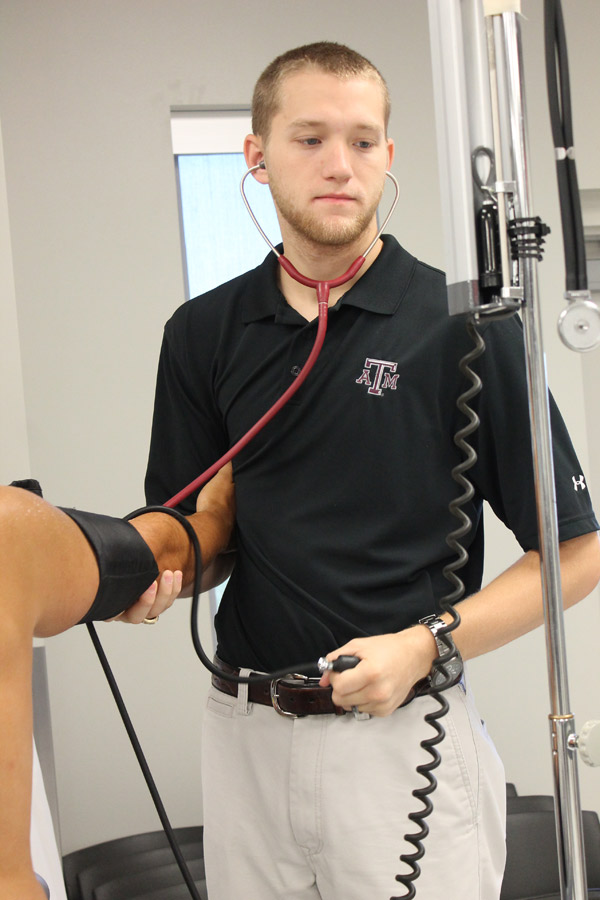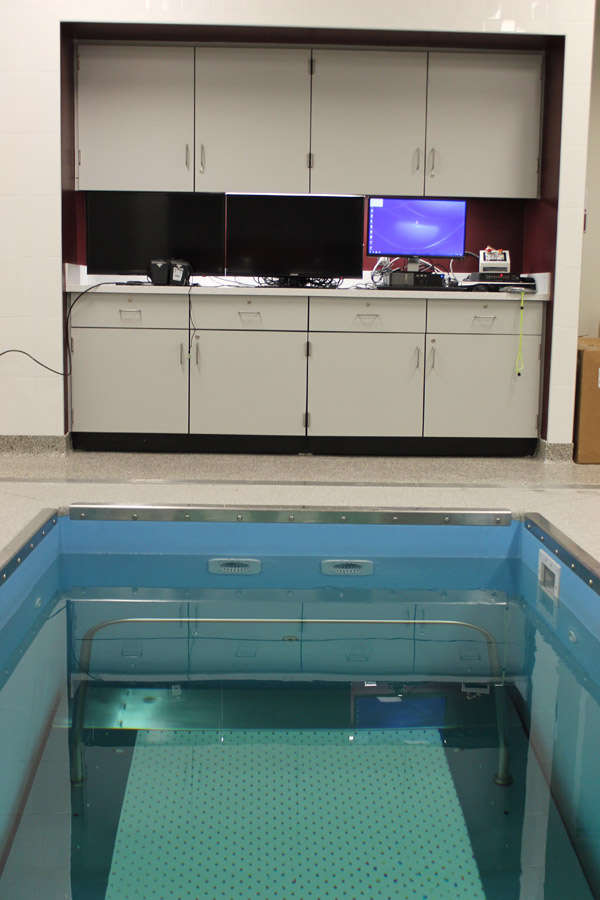To schedule, please contact us at semartin@tamu.edu
ANAEROBIC THRESHOLD (AT) / LACTATE ANALYSIS
 The Anaerobic Threshold (AT) is a point at which each person’s metabolism shifts from Aerobic (using oxygen for fuel) to Anaerobic (not using oxygen for fuel). The point at which every person crosses their AT is unique and can be an indicator of aerobic fitness. The higher the exercise intensity at which a person crosses their AT, the more aerobically fit they are considered to be. We can determine your AT via a treadmill or cycle ergometer test.
The Anaerobic Threshold (AT) is a point at which each person’s metabolism shifts from Aerobic (using oxygen for fuel) to Anaerobic (not using oxygen for fuel). The point at which every person crosses their AT is unique and can be an indicator of aerobic fitness. The higher the exercise intensity at which a person crosses their AT, the more aerobically fit they are considered to be. We can determine your AT via a treadmill or cycle ergometer test.
BODY COMPOSITION ANALYSIS
Accurate measurement of body composition provides valuable information for assessing, monitoring and treating a variety of diseases and disorders. Body composition measurement with dual-energy X-ray absorptiometry (DEXA) can look beyond weight and the traditional body mass index (BMI) to determine body fat distribution – an important risk factor in a variety of serious diseases. Information from DEXA exams can prove valuable in conditions, such as:
- Obesity
- Anorexia nervosa
- Cysitc fibrosis
- Wasting syndrome (caused by HIV / Aids)
- Chronic renal failure
In all these cases, body composition measurement contributes to a thorough patient evaluation and helps physicians monitor the effects of therapy, diet, or exercise. Body composition scans with DEXA provide precise and accurate data on bone and tissue composition, including bone mineral density (BMD), lean tissue mass, and fat tissue mass. They provide both total body data and regional results (trunk, arms, legs, pelvis, and android / gynoid regions). The measurements are fast and non-invasive.
We use DEXA scans for body composition because it accurately shows exactly where fat is distributed throughout the body. Lunar DEXA systems directly measure and calculate total fat, lean, and bone tissue, instead of estimating body composition.

CARDIOVASCULAR HEALTH PROFILE (CHP)
Cardiovascular Health Profile (CHP) includes:
- Blood chemistry analysis
- Pulmonary function analysis
- Muscular strength & flexibility tests
- Resting & exercise electrocardiogram (ECG)
- Resting & exercise blood pressure
- Body composition analysis (includes a full body dual energy x-ray absorptiometry scan)
- Physical exam by a Physician
- Cardio exercise testing (treadmill / ergometer bike)
- Consultation with an exercise physiologist
CARDIOVASCULAR RISK PROFILE (CRP)
A Cardiovascular Risk Profile (CRP) includes:
- In-depth medical health history
- Selected laboratory tests: Total cholesterol, HDL-cholesterol, triglycerides, glucose, selected liver & kidney enzymes, electrolytes
- Resting blood pressure & pulse
- Resting 12-lead electrocardiogram (ECG)
- Strength & flexibility
- Body composition analysis (includes a skinfold assessment plus height & weight)
- Individualized written reports
- Group consultation with an exercise physiologist (if requested)
RESTING METABOLIC RATE (RMR) MEASUREMENT
Resting Metabolic Rate (RMR) is the number of calories your body burns each day without physical activity. Each individual has a unique metabolic rate, which accounts for as much as 75% of the total daily calories our bodies need (or up to 100% in the critically ill patient). An accurate Metabolic measurement is the key to any successful weight management or fitness program.
Even among individuals of similar height and weight, an RMR can vary significantly – by as much as 900 calories per day. This variability makes an accurate measurement of metabolic rate even more important for a personalized successful weight management program.
SPORTS PERFORMANCE TEST (SPT)
The Sports Performance Test includes:
- Physical exam by a physician
- Blood chemistry analysis
- Cholesterol: Total cholesterol, HDL & LDL levels
- Triglycerides, & HDL-cholesterol ratio
- Glucose: analyzes blood sugar level
- Liver & kidney enzymes: analyzes renal & hepatic function
(Additional blood testing available upon request, at additional cost)
- Pulmonary function analysis: Determines respiratory (breathing) capacity through accurate computer analysis and helps identify respiratory problems such as asthma and emphysema
- Muscular strength & flexibility tests: Handgrip strength using a hand dynamometer, muscle strength / endurance tests, and lower back & leg flexibility
- Resting & exercise electrocardiogram (ECG)
- Graded exercise test on either a treadmill or stationary bicycle (ergometer)
- Exercise blood pressures and 12-lead ECG readouts of your heart response to exercise during all stages of the exercise test
- Estimated maximum oxygen uptake
- Resting & exercise blood pressure
- Body composition analysis (includes a full body dual energy x-ray absorptiometry scan)
- Measure of bone mineral density, body fat percentage, & lean body mass (most accurate measure of body composition)
- Information from DEXA exams can prove valuable in conditions, such as obesity, anorexia nervosa, cystic fibrosis, wasting syndrome and chronic renal failure
- Maximum oxygen uptake & respiratory threshold (anaerobic threshold) measure via metabolic cart
- Consultation with an exercise physiologist
Visit the Huffines Institute Medical Testing Services Marketplace